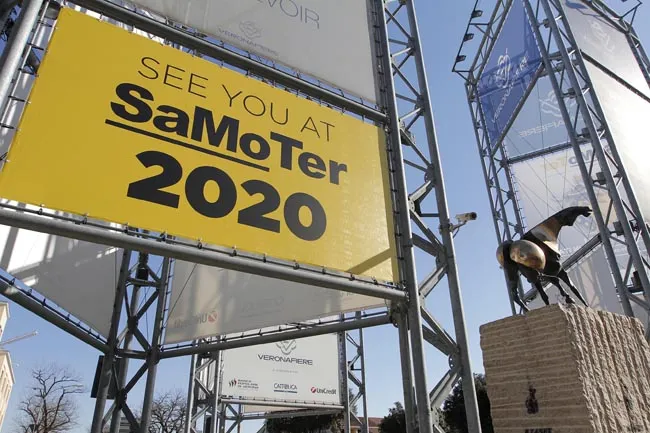Sales of earthmoving machinery were strong across the globe in 2018, jumping 23% over 2017. In total, 825,000 earthmoving machines were sold in 2017, while 2018 saw sales leap to more than one million units. These figures have been revealed in a report compiled by Prometeia for
The data also shows that the three-year period from 2016 to 2018 was even better (+8%) than the cyclic expansion phase for the 2003 to 2007 period.
The record result for 2018 was driven by a combination of several factors according to Prometeia’s data. This was boosted by from investments in construction on a global scale in excess of €7,150 billion (11.6% of total global GDP).
The report says that in most parts of the world, the market posted two-figure growth, attaining new historical peaks in the United States (+36% on a trend basis), India (+48%), China (+35%) and the rest of the world (+20%).
Meanwhile North America and China were the driving forces behind almost two-thirds of overall growth, with a combined market share of 50%, followed by Western Europe (18% of market share) and India (7% of the world market).
The tailender of this positive trend is Western Europe, with a growth rate of just 3% and 182,000 machines sold. This slowdown was in any case expected and saw a reduction of more than three percentage points on the global market ranking compared to 2017.
The market leader for sales is Germany (23%), closely followed by the United Kingdom (22%). Italy ranks fourth, with a market share of 9%. On the other hand, taking a closer look at changes in trends, Spain performed well in 2018 (+48% compared to the previous year), as well as Italy (+16%) and the United Kingdom (+9%). More modest growth, however, saw seen for France (4%), Belgium (2%) and the Netherlands (1%). There was a somewhat surprising setback of -8% in Germany, partly because of a shift on the market towards larger machines. On closer analysis, Germany’s market share in Western European decreased by 3% compared to 2017.
In Central & Eastern Europe, the market giants are Russia and Poland, respectively representing 42% and 18% of the global market share. These two countries were the driving force in 2018 for increased sales, with particularly significant growth rates: +59% for Poland and +32% for Russia. The third player in this part of the world is Turkey (16% market share), having been overtaken by Poland in just two years, posting a downturn in 2018 of 32% on a trend basis.
As regards product dynamics, the earth moving machinery market in 2018 was characterised by sustained and widespread growth for all types of plant: track-laying excavators (+25%), mini-excavators (+15%), wheel loaders (+19%) and compact mini loaders (+41%). A significant trend is especially emerging on mature markets highlighting a shift towards “light equipment”.
Light equipment, according to data processed by Prometeia, is also progressively become more significant weight on the Chinese market, so much so that in 2018 demand for mini-excavators came to represent almost 20% of total, up from 10% in 2010.
India has established itself as the most dynamic market, with 8.3% growth for total construction investments.
Central-Eastern Europe and Turkey also saw an average annual percentage for 2018 higher for construction investments (+5.7%).
North America grew by 1.7% for total construction investments. Latin American and Japanese markets were both negative.
The focus on Western Europe highlights an evident downturn in growth in construction fields in France and the United Kingdom. Italy stands in the second half of the ranking, with growth of 2.3% in total construction and 3.4% in residential construction.
The confidence climate in the German market remains at a high level, even though companies with obstacles to production growth have increased since the second half of 2017. In particular, in Germany and France the main constraint is a shortage of labour, while in Spain or the United Kingdom the main brake is demand.
Sustained dynamics for investments in Central Eastern Europe, with the exception of the construction market in Turkey, going decidedly against the trend compared to 2017. Overall, however, the implementation of EU funds during the 2014-2020 programming cycle has supported construction, particularly civil engineering.
On the Asian market, India recovered rapidly after the shock early in 2017, with added value for construction reaching 11.5% in the first quarter of 2018. Growth in infrastructure spending in China was significantly reduced last year, down from +17.8% of nominal investments in infrastructure in 2017 to a much more timid +3.8%.
On an international scale, the macro-economic scenario indicates a slowdown stage for the global economy, with risk factors that can be identified in the volatility of financial markets, commercial tensions on a global scale, the uncertainties of Brexit, the Chinese Hard Landing and in certain aspects of political uncertainty of variable intensity in a number of geographical areas around the planet.
The prospects for construction in the period 2019-2021 indicate still moderate growth in 2019, with a gradual recovery starting from 2020. In Western Europe, the trend towards slower rates of expansion should prevail, while favourable prospects are evident for countries in Central Europe. However, the Turkish market will still be experience difficulties in 2019, not the least because of o political tensions and uncertainties linked with investments.
According to the Outlook presented by Prometeia, 2019 will be a year of adjustment for the global earthmoving machinery market. In the face of increasing uncertainty, the propensity to invest will, overall, record a moderate decline.
Earthmoving machine sales improved
have increased since the second half of 2017. In particular, in Germany and France the main constraint is a shortage of labour, while in Spain or the United Kingdom the main brake is demand.
Sustained dynamics for investments in Central Eastern Europe, with the exception of the construction market in Turkey, going decidedly against the trend compared to 2017. Overall, however, the implementation of EU funds during the 2014-2020 programming cycle has supported construction, particularly civil engineering.
April 2, 2019
Read time: 5 mins








